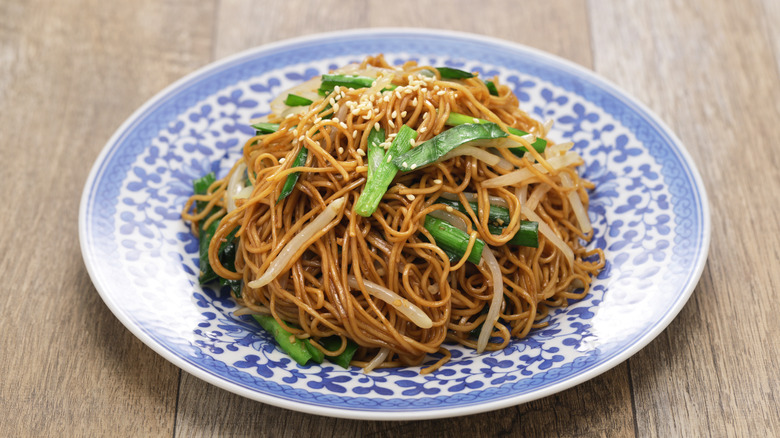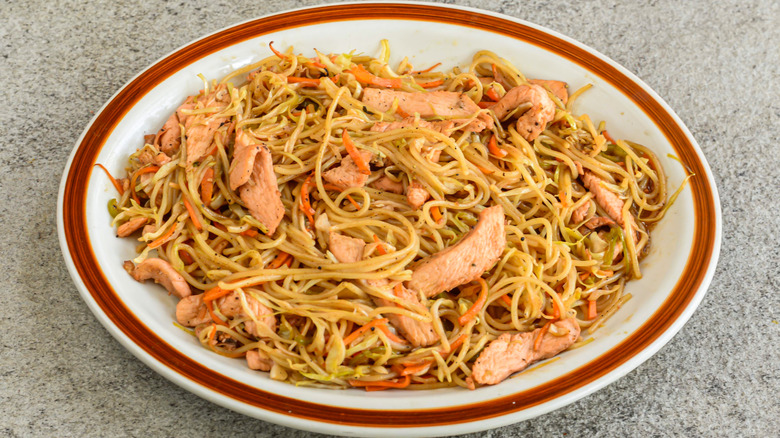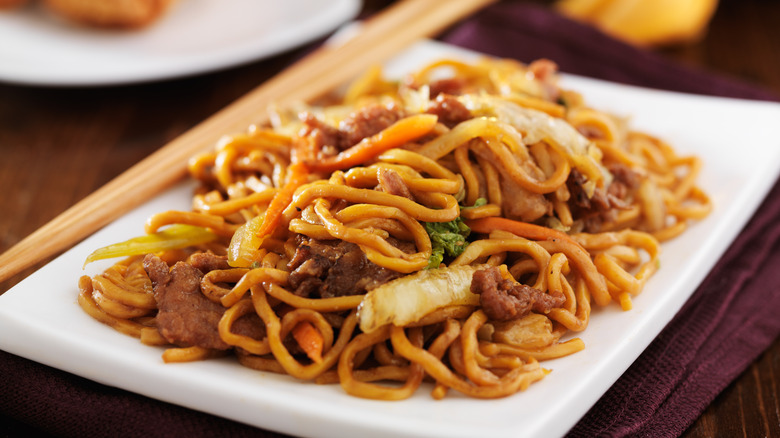Lo Mein Vs Chow Mein: The Difference Explained
For many people, nothing warms the belly quite like Chinese cooking (almost 31% of Americans order from Chinese restaurants at least once a week, according to Gitnux). Besides crispy egg rolls, piping hot wonton soup, and pleasantly chewy fried rice, chow mein, along with its slurpable cousin, lo mein, are two of the cuisine's biggest players.
To the untrained eye (or should we say, palate), these dishes may appear almost identical — both feature Chinese egg noodles (made from wheat flour, water, salt, and eggs), bite-sized pieces of meat, vegetables, and sauce. To confuse matters even further, they also share strikingly similar names ('mein' is the Chinese word for noodles). And while it can be said that chow mein and lo mein are equally delicious, there is actually a distinct difference between these two dishes, and it all comes down to the manner in which they are cooked. Put simply, chow mein means stir-fried noodles, while lo mein is a dish of noodles that have been tossed in sauce and mixed.
The main characteristics of chow mein
Chow mein has been catching a ride on our collective chopsticks since the mid-19th century when it was introduced by Chinese immigrants as one of the earliest examples of American-Chinese cuisine. The first versions made heavy use of vegetables but later embraced meat and sauce to appease American taste buds. Since its arrival, chow mein has exploded in popularity, popping up on menus the country over (you'd be hard-pressed to find an American-Chinese restaurant today that doesn't serve some version of it).
The chow mein most Americans are familiar with uses fresh or dried noodles that are parboiled and then stir-fried in a wok or pan alongside meat and vegetables, before being dressed sparingly in a light, often soy-based sauce. This style of cooking is said to hail from Shanghai and gives the noodles their lovely, springy texture, which is this dish's hallmark.
However, there's more than one way to enjoy chow mein. In Hong Kong, it's commonplace to boil the noodles and then shape them into a sort of pancake, before frying them and topping with the other ingredients. There's even such a thing as a chow mein sandwich (literally a bun or two slices of bread stuffed with chow mein).
The lowdown on lo mein
Just like its cousin chow mein, lo mein originated in Chinaand underwent some subtle changes upon reaching our shores (the version we enjoy, for example, has a thicker sauce than the kind used in traditional Chinese lo mein, which by contrast has a brothier consistency).
The American-Chinese style of lo mein takes fresh, fully cooked noodles and adds them to a pan or wok with meat and vegetables that have already been stir-fried, along with a generous serving of sauce (made by combining ingredients like soy sauce and cornstarch, which is used as a thickening agent). These elements are then tossed or stirred together, as the final step in the cooking process.
Pre-cooking the noodles and minimizing the amount of time they spend in the pan — combined with the liberal use of a thicker sauce — helps to give lo mein a softer texture than the crunchy, almost dry quality that is characteristic of chow mein. All of this to say that if you muck up your next takeout order, don't panic — the mein you end up getting may not be your first choice, but you won't find a more suitable (or mouthwatering) stand-in.


